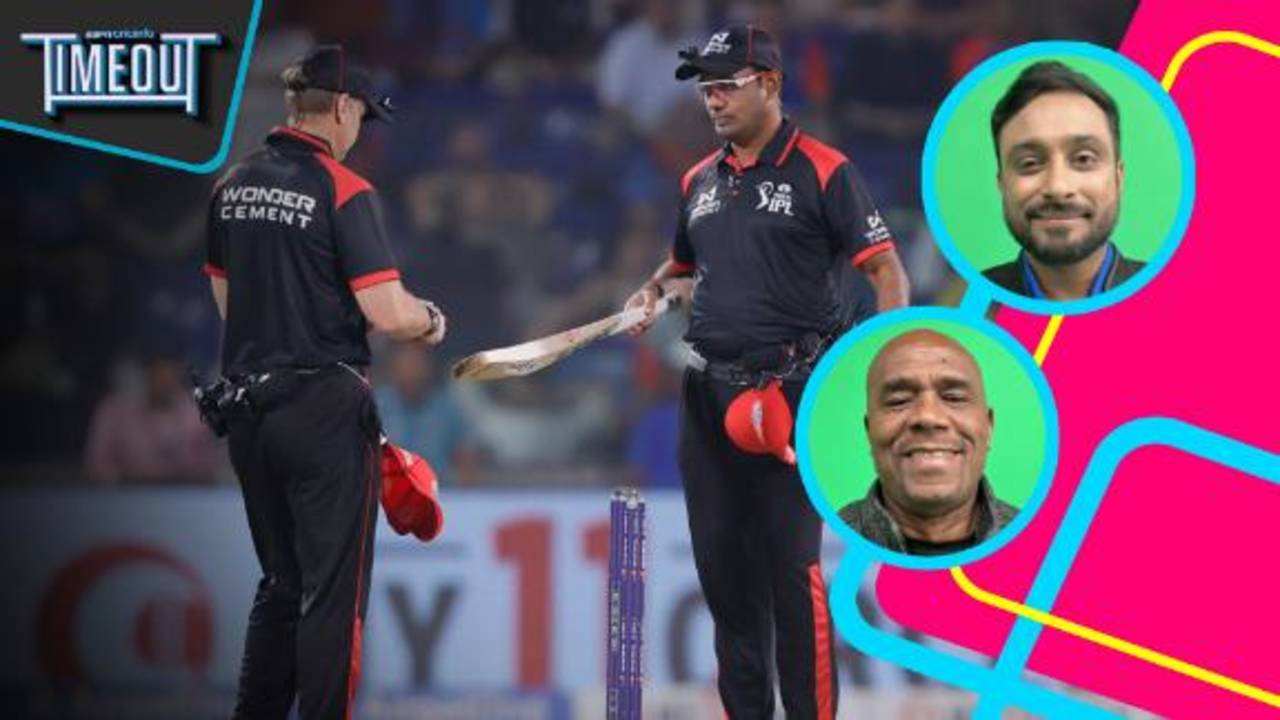The IPL's crackdown on oversized bats, explained
Every batter who takes the field in the IPL is now having to go through a bat-gauge test. Here is why
Nagraj Gollapudi
17-Apr-2025
Why has the IPL started measuring bats all of a sudden during IPL 2025? That has become a significant question ever since April 13, when match officials began using a gauge to measure bats.
While the IPL has not put out an official statement on the reasons, ESPNcricinfo has learned the move has been made with an eye on maintaining the balance between bat and ball and ensuring that batters do not derive an undue advantage from using bigger bats.
It is understood that the move was initially discussed by key decision-makers of the IPL before it was ratified by the tournament governing council and formally introduced on April 13. While the IPL has checked bat dimensions in previous seasons, the process involved the fourth umpire measuring the bat dimensions on the day before the match, with players chosen at random. It did not matter, then, if the player would be part of the team on match day. And not all bats of the player were checked, which meant that a batter could have one bat tested and walk in with another on match day.
Why now?
To plug that loophole, the IPL decided during discussions at the start of the 2025 season that it would be better check bats during the match rather than during training. It is understood that some match officials had privately expressed concern over the size of some bats players had been using. So instead of being subjective and selective in their assessment, it was decided a better approach would be to uniformly check the legality of the bats of all players during a live match.

Girish TS/ESPNcricinfo Ltd
It is understood that the IPL decided to adopt a rule that was originally used by the ECB. In 2018, the ECB introduced, as part of its domestic playing conditions, checks on bat sizes to make sure they conformed to Law 5 of the MCC's Laws of Cricket, which restricts the thickness of bat edges to 4cm (1.56 inches), the overall depth of bats to 6.7cm (2.64 inches), and their width to 10.8cm (4.25 inches).
How does the bat gauge work?
The guage is a rectangular implement with a house-shaped cut-out through which the bottom part of the bat is inserted. The cut-out conforms to the bat dimensions permitted under Law 5, which is also part of the IPL playing conditions. To be deemed legal to use, the bat must be able to pass through the gauge, even if it has been fitted with "[p]ermitted coverings, repair material and toe guards, not exceeding their specified thicknesses"

The gauge in use at the IPL to test bat sizes•ESPNcricinfo Ltd
When do the checks happen?
It is understood that the IPL informed all teams before mandating the bat checks from April 13. Teams were also given bat gauges so their players could themselves check their bats before the match.
On matchdays, on-field umpires carry a bat gauge each to assess the bat of the incoming batter. The fourth umpire is tasked with checking both openers' bats at the start of each innings. Any bat was found exceeding the specified dimensions is marked and cannot be used during a match. In case a batter asks for a bat change, the new bat is also checked.
So far, only two bats have failed the gauge test: they belonged to the Kolkata Knight Riders pair of Sunil Narine and Anrich Nortje.
What are the sanctions?
Just like the ECB has done, the IPL too has put the onus on players to ensure that their bats comply with Law 5. However, there is a significant difference when it comes to sanctions. The ECB has imposed severe sanctions for any breach, as Essex bitterly experienced during the 2024 County Championship season when they were docked 12 points after one of their batters used an oversized bat during the opening match of their season.
The IPL has decided not to impose any sanction other than disallowing bats that have failed the gauge test. While the ECB's bat checks are random, the IPL checks every bat that enters the field of play.
It is understood that batters have been caught off-guard by the move. A tailender at a title-winning team was left in a spot when his entire set of bats, numbering seven or eight, failed to pass through the gauge. Such a situation could prove particularly tricky for overseas batters, particularly those whose bat manufacturers are based outside India.
Specialist batters usually request manufacturers to design bespoke bats with custom measurements. In the past, since bat checks were only carried out at random by match officials, and usually only on the eve of the match, there was a certain amount of leeway for players to get away with measurements that exceeded permissible limits. Even if a bat or set of bats was rejected on training day, a player could still use a matchday bat that had never gone through the gauge.
The IPL has decided to discourage such actions in the quest to maintain the balance between bat and ball.
Nagraj Gollapudi is news editor at ESPNcricinfo
